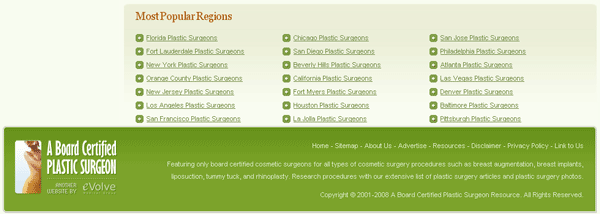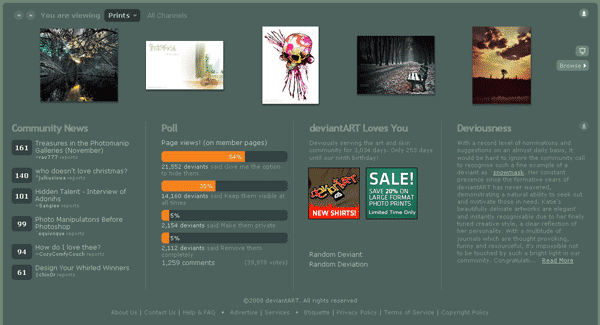
Footer Link Optimization for Search Engines and User Experience
Site after site that I visit lately has been showing a tendency for using footer links to run their internal SEO link structure and anchor text optimization. While this practice in years past held value, today I rarely ever recommend it (and yes, SEOmoz itself will be moving away from using our footer for category links soon). Here's why:
- Footer links may be devalued by search engines automatically
Check out the evidence - Yahoo! says they may devalue footer links, Bill Slawski uncovers patents suggesting the same and anecdotal evidence suggests Google might do this (or go further) as well. Needless to say, if you want to make sure your links are passing maximum value, it's wise to avoid the footer (particularly the footer class itself). - Footer links are often not the first link on the page to a URL
Since we know that the first link on a page is the one whose anchor text counts and footer links, while anchor text optimized, are often a second link to an already-linked-to target, they are likely not to have the desired impact. - Footer links get very low CTR
Naturally, since they're some of the least visible links on a webpage, they receive very little traffic. Thus, if algorithms like BrowseRank or other traffic metrics start to play a role in search rankings, footers are unlikely to have a positive impact. - Footer links often take a page beyond a healthy link total
Many pages that already have 80-100 links on the page are going to lose out when they add a footer with another 30-50 links embedded. The link juice passed per link will go down and the value of each individual link is lowered. - Footer links can be a time suck
The time you spend crafting the perfect link structure in the footers could be put towards more optimal link structures throughout the site's navigation and cross-linking from content, serving both users and engines better.
That's not to say I don't suggest doing a good job with your footers. Many sites, large and small, will continue to use the footer as a resource for link placement and, just as with all other SEO tactics that fade, they do carry some residual value. Let's walk through a few examples of both good and bad to get a sense for what works:
Thumbs Up: Shopper.Cnet.com

I like the organization, the clear layout, the visibility and the fact that they've distinguished (through straight HTML links vs. drop downs) which links deserve to pass link juice and ranking value. I'm also impressed that I actually see a "Paris Hilton" link in the footer yet am not completely unaccepting of the idea that it could be there entirely naturally, simply as a result of what's popular on CBS.
Thumbs Down: Hawaii-Aloha.com

These are my least favorite kinds of footers. The links are just squashed together, the focus is obviously on anchor text, not relevance, the links are hard to see and read and there's little thought given to users. The links don't even look necessarily clickable until you hover.
Thumbs Up: VIPRealtyInfo.com

When I searched for "Dallas Condos", I was sure I'd find some examples for thumbs down, which is why I was so thrilled to find VIPRealtyInfo, a clearly competitive site in a tough SEO market doing a lot of things right. Yeah, there's some reasonable optimization in the anchor text, but it's definitely not overboard and the links are useful to people and search engines. The visual layout and design quality gives it an extra boost, too - something that can't be overstated in importance when it comes to potential manual reviews by the engines.
Thumbs Down: ABoardCertifiedPlasticSurgeonResource.com

The site's done a great job with design - it's really quite an attractive layout and color scheme. The links in the "most popular regions" aren't that bad; it's really the number of them that makes me worried. If they'd stuck to one column, I think they'd easily pass a manual review and pass good link juice (rather than spreading it out with so many links in addition to everything else on the page). The part that really sent me over the edge though was the two sentences in the green box, laden with links I didn't even realize were there until I hovered. Technically, there's nothing violating the search guidelines, but I wouldn't put it past the engines to come up with smart ways to devalue links like these, particularly when their focus is so clearly on anchor text, not user value.
Thumbs Up: Food.Yahoo.com

Again - great organization, good crosslinking (remaining relevant, then branching out to other network properties) and solid design. Even the most aggressive of the links on the right hand side appear natural and valuable to users, making it hard for an engine to argue they shouldn't pass full value.
Thumbs Sideways: DeviantArt.com

It's huge - seriously big. And while it's valuable for users and even contains some interesting content, it's not really accomplishing the job of a footer - it's more like a giant permanent content block on the site. The arrow that lets you close it is a good feature, and the design is solid, too. However, the link value really isn't there and the potential for big blocks of duplicate content across the site makes me a bit nervous, too.
So what can we take away from these analyses? A few general footer-for-SEO rules of thumb:
- Don't overstuff keywords in anchor text
- Make the links relevant and useful
- Organize links intelligently - don't just throw them into a big list
- Cross-linking is OK, just do it naturally (and in a way that a manual review could believe it's not solely for SEO purposes)
- Be smart about nofollows - nearly every footer on the web has a few links that don't need to be followed, so think about whether your terms of service and legal pages really require the link juice you're sending
- Make your footers look good and function well for users to avoid being labeled "manipulative" during a quality rater's review
What's your take on footers for SEO, and how do you use them or avoid them?
p.s. If you're thinking about footers from a layout and design perspective, check out Matt's older (but still good) post on 19 Gorgeous Website Footers.
p.p.s. Happy Thanksgiving! This year, I'm thankful for (among many other things) Danny's awesome post calling out spam and manipulation in the engines (and Google's responses, too).
The author's views are entirely their own (excluding the unlikely event of hypnosis) and may not always reflect the views of Moz.




Comments
Please keep your comments TAGFEE by following the community etiquette
Comments are closed. Got a burning question? Head to our Q&A section to start a new conversation.